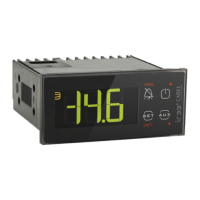25
ENG
ir33plus +0300028EN rel. 1.1 - 05.05.2017
The following parameters are involved in the explanation of the settings
for A4 and A5.
Par. Description Def Min Max UOM
A4 Multifunction digital input 1 con guration
(DI1)
See the previous table
0/3
(IR33M)
014-
A5 Multifunction digital input 2 con guration
(DI2)
See the previous table
0 0 14 -
A6 Stop compressor on external alarm
0 = compressor always o ;
100 = compressor always on
0 0 100 min
A7 Digital alarm input delay0 = control
outputs unchanged
0 0 250 min
Ado Light management with door switch 0 0 1 -
c7 Maximum pump down time (PD)
0 = Pump down disabled
0 0 900 s
d5 Defrost delay at start-up (if d4=1) or from
DI
0 0 250 min
d8 High temperature alarm bypass time after
defrost (and door open)
1 0 250 hr/
min
d8d Alarm bypass time after door open 0 0 250 min
dI Maximum time between consecutive
defrosts - 0 = defrost not performed
8 0 250 hr/
min
Tab. 5.e
1 = Immediate external alarm
Application: external alarm that requires immediate action (for example
high pressure alarm or compressor thermal overload). When the alarm is
activated:
1. the following actions occur:
• a signal is shown on the display (‘IA’);
• the icon ashes;
• the buzzer is activated, if enabled;
• the alarm relay is activated, if selected;
2. and the actuators behave as follows:
• compressor: operates depending on the values assigned to
parameter ‘A6’ (stop compressor on external alarm).
• fans: continue operating according to the fan parameters (“F”).
Note when the compressor stops, the minimum compressor on
time (“c3”) is ignored.
2 = Delayed external alarm
The delayed external alarm is equivalent to the immediate external alarm,
however with the addition of a delay A7 before the signal (“dA”).
Application: this con guration is especially useful for managing the low
pressure alarm. In fact, when starting for the rst time, the unit often
detects a low pressure alarm due to the environmental conditions rather
than a unit malfunction. Setting a delay for the alarm (par. A7) will avoid
false signals. In fact, by suitably calculating the delay, if the low pressure
is due to environmental conditions (low temperature), the alarm will be
automatically reset before the delay has elapsed.
Note if “A7”=0 activation of the alarm does not cause the compressor
to operate according to the values assigned to parameter ‘A6’ (stop
compressor on external alarm); on the other hand, the “dA” signal is
displayed, the icon
ashes, the buzzer and the alarm relay (if selected)
are activated; the delayed external alarm is thus signal-only.
3 = Probe shown on the display (IR33M models)
On thermometer-only models, this setting selection is used to exploit
the digital input in order to show, on the display, the probe selected by
parameter “/tI” or the rst enabled probe (see parameters “/A2”,”/A3”,”/A4”).
In practice, if the contact is open, the probe selected by parameter “/tI” is
shown, whereas, if the contact is closed, the rst enabled probe is shown.
Note: if more than one digital input is con gured as the probe
selection, the probe selected by parameter /tI is displayed when at least
one of the inputs is open.
3 = Enable defrost (all other models)
Application: any defrosts called when the contact is open remain pending
until the contact closes. The various possibilities are shown below.
A4 = 3
Contact Defrost
Open Not enabled
Closed Enabled
Closed without
request from the
controller
Not performed
Closed with in
progress
When the digital input opens, the defrost is immedia-
tely stopped and the unit restarts normal operation
(without performing the dripping or post-dripping
stages). The
LED starts ashing to indicate that the
defrost call is pending, awaiting the next enabling
signal (closing of the contact), when the defrost will
be performed completely.
Tab. 5.f
Note this function is useful to prevent defrosts on units accessible to
the public during opening times.
4 = Start defrost from external contact
Application: this function is useful for performing defrosts in real time. To
perform the defrosts, connect a cyclical, mechanical or electronic timer
to the selected digital input: a series of units can be connected to the
same timer, setting di erent values for parameter d5 (defrost delay from
multifunction input) to avoid simultaneous defrosts.
Important: for 12 Vac and 12/24 Vac versions. When connecting a
series of units to the same timer, the best solution is to insulate all the
contacts galvanically, inserting an intermediate relay for each contact.
ON
OFF
ON
OF

